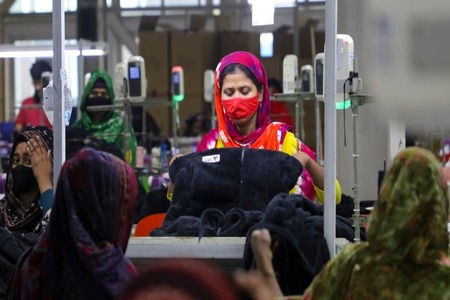
Critical approach to fashion industry
YarnsandFibers News Bureau 2019-08-15 18:00:00 –In a long-ago era before the world worried about climate change, social justice, ecology, etc., sustainable fashion was based on the snob value of pure wool, pure cotton and pure silk.
In a long-ago era before the world worried about climate change, social justice, ecology, etc., sustainable fashion was based on the snob value of pure wool, pure cotton and pure silk.
Synthetic fabrics, initially hailed with wonder because they laundered reasonably well the first few times and did not require ironing, were subsequently regarded with disdain by true fashionistas.
But all that has changed in a rapidly changing world.
The most up-to-date fashions are becoming more affordable as they come from countries such as China, India, and Bangladesh, countries in which the poverty stricken are exploited and paid the lowest possible wages for turning out incredible quantities of high fashion garments.
Human rights activists tell us not to buy these clothes because to continue buying will encourage further exploitation, and these people will never emerge from the cycle of poverty. But logic tells us that if we don’t buy the high-fashion low-cost garments, the people producing them will be jobless and even poorer than they are already. Moreover, the natural instinct for snapping up bargains also motivates our purchases.
All these factors and more were discussed at a fascinating seminar held at the Tower of David Museum in Jerusalem last month under the title of Overall – a word that can be alternately interpreted as an item of clothing, or as comprehensive exploration into the environment or specific subject matter.
In this case the subject matter was fashion, not in terms of the regular runway visuals but from the aspect of the first thread, the initial design sketch, the knitting or weaving of yarns, the mix of colors, marketing, purchasing, slave labor, new technologies, disposal of surplus and more.
The word “fashion” usually conjures up glamor, and in some parts of the world fashion continues to be elegant and glamorous. But for the most part, it is a series of copy-cat trends in which a handful of styles are repeated in different hues and fabrics, so that what women have in their closets becomes the next best thing to a uniform.
Most women would disagree and claim that they’re wearing what’s in vogue. But in fact, although they would like to think of themselves as unique, they are too often part of a herd mentality. In times of economic crisis, the little black dress that can so easily be dressed up or dressed down depending on the accessories or lack of them becomes an essential item of attire. Curiously, when the economy is on an even keel, necklines are lower and hemlines are higher. They don’t quite meet at the navel, but near enough. This is a fashion interpretation of less is more.
According to several experts – Atnyel Guedj, Liroy Choufran, Michal Levi Arbel and Natali Itzhakov, who write, lecture, teach and advise on fashion and its effect on the world – there isn’t much time for a trend in fashion to take on the identity of a uniform. The reason is that we live in what is known as a Fast Fashion era. Few women wear a garment more than 10 times, and far less if they’ve posted a photograph of themselves in the garment on Instagram. Appearing in the same garment twice on Instagram is a big no-no in ego etiquette, tantamount to social suicide, so women frequently discard barely worn garments in order to buy new ones. The discards go to thrift shops and charity organizations, and those in really good condition are often recycled and redistributed in places like Africa, where there is widespread poverty and where the poor do not earn enough money with which to buy genuinely new clothes.
What these speakers and others talked about at the seminar was sustainable fashion, in the sense of bringing about change in the composition and production of fashion-related products with the aim of using less water, less chemicals, less harmful products such as plastic, all with the goal of helping to save the planet.
When someone buys a garment, they give little or no thought to fashion being one of the greatest polluting industries in the world.
The whole concept behind the seminar was to make people think differently about fashion – what goes into it, and what damage it incurs.
Sustainable fashion, which has become a global movement with responsibilities shared by producers and consumers, is really a misnomer, because the sustainability refers not to the fashion, but to the planet.
Guedj, who has worked for multi-national corporations in the UK and Paris, has managed factories and fashion start-ups in China and the US, and has been responsible for product development in Israel, is acutely conscious of the environment.
Some of the disquieting information that he presented included the little-known fact that more than 8,000 chemicals are in use in the fashion industry, a factor which he said “is too dangerous for the planet,” and one of many challenges of the global environment.
He also noted that due to new production methods, and the new culture of online consumerism, an alarming number of top-ranking companies as well as many smaller companies are going out of business, “and the purity of fashion is getting lost.”
As far as stores are concerned, Guedj quoted figures of store closures in the US in what he termed “a retail apocalypse.” Thousands of clothing stores across America close annually, with somewhere in the range of 15,000 closing between 2015 and 2018.
Because so much in various stages of production is done by robots or computers, salaries in the fashion industry are well below the basic wage, except in China where they are higher, but not much.
Everywhere else, including in Western countries, workers in the fashion industry cannot survive on what they earn, he said.
Fashion production is far in excess of consumption. There are 150 billion fashion items produced each year, of which 80 billion are purchased. People are endlessly buying clothes that have become so much more affordable, and in the process are discarding barely worn items of apparel. Of the 150 million items that are produced, only 1% are recycled, with the remaining surplus either incinerated or placed in landfills.
The industry generates more than $2.4 trillion a year, which according to Guedj, “is more than all the aviation companies combined.”
The urge to buy, he noted, derives from prices on every other commodity increasing whereas in fashion they have decreased. Over the past 20 years, he said, fashion has come down in price by 10.2%. “We buy more and wear our clothes less.”
Clothes used to be laundered at least 20 times before they were given away, he said. Now, they’re seldom laundered more than 10 times.
He was extremely bothered that despite so much having been modernized in fashion production, there is still a sweatshop environment.
In April 2013, the Rana Plaza building in Dhaka, Bangladesh, collapsed. The building contained five garment factories with many workers, of whom 1,134 were killed and more than 2,500 injured. Since then, said Guedj, another 500 have died in other fashion plants. “How many more have to die so that we can buy cheap fashion?” he asked.
Other than in places threatened by floods, much of the world is facing a depletion of water resources. The dyeing and treatment of garments accounts for roughly 17% to 20% of global water consumption, said Guedj. Just to make a pair of jeans and a cotton T-shirt requires 2,400 liters of water, he noted, before reeling off several other disturbing statistics and also underscoring that testing shows that chemicals are hazardous in all textiles.
Liroy Choufran, whose talk was titled “The Idolatry of Shopping,” started out with a video of a department store sale, in which crowds of people were pushing against and past each other in an attempt to get inside while security personnel held back the wild stampede.
“Why is going to sales so important?” he asked. “Because we believe it will do us good – make us feel good.”
Where does this psychology come from?
Like most things, it’s rooted in history. In the horse and carriage days of the 18th and 19th centuries, most people lived in rural villages, far from the big cities. This gave them a sense of inferiority, isolation and not belonging. Thus, when they had occasion to visit the metropolis it was like a vacation, and they bought anything and everything that was unavailable in the village.
People today want to be part of the modern metropolis, said Choufran, but the psychology is slightly different. In modern countries people can be free of religious restrictions, and can rid themselves of the feeling that God rules the world. “But this leaves a void, and to fill it we go out and choose the newest, most modern consumer goods.”
Many people think it’s just wonderful to wander through department stores and shopping malls, he said.
The urge to buy is also influenced by commercials on electronic media and advertisements on billboards, and in newspapers and magazines. By featuring celebrities and minimal text, some of the advertisements create a false promise on how a person’s life can change by buying a particular product.
Choufran showed an example of a naked Yves Saint Laurent, sitting in a Jesus pose, with something resembling a halo behind his head. This advertisement provoked so much spoken and written comment that it aroused wide public curiosity, and people flocked to where they could by YSL creations. Similarly, it was not by chance that Saint Laurent called his signature perfume Opium, said Choufran.
Taking temptation a step further, Michal Levi Arbel said that when she first became a fashion writer, she didn’t understand the meaning of disposable fashion, which in essence means wearing a garment once or twice and throwing it away. But then she realized that fashion chains would advertise a sale every few weeks, in which only 30% of the merchandise was on sale. The other 70% of the display was new stock, for which consumers made a beeline. That’s why so many garments have a short life span.
Instagram also contributes to the discarding of what’s in the closet. Anyone who uses Instagram regularly sees people in something more modern than anything they own, and suddenly all their clothes seem old, so they go out and buy replacements.
The problem, she said, is that there are so many discards that secondhand stores can no longer deal with the quantities of unwanted clothes that they receive. “Twenty-one million tons of textile waste each year has a negative impact on the environment,” she declared.
There’s a lot more ecological awareness in Europe than there is in Israel, said Natali Izhakov. Israel is not interested that 18 billion pieces of plastic end up in the ocean each year, “and that’s just the tip of the iceberg,” she stated.
Quoting celebrated British fashion designer Dame Vivienne Westwood, Izhakov advised: “Buy less. Choose well.”
But she admitted that although such advice is sound at face value, there is the FOMO syndrome: fear of missing out.
“We are all afraid of missing out, not belonging, not being relevant,” Izhakov said, but predicted that over the next decade people will become more JOMO – joy of missing out – where people who don’t really want to participate in a project or a social event will have the courage to say, “I really don’t want to!”
Courtesy: The Jerusalem Post
Market Intelligence
Ask for free sample Report

experience
Customer Base
dedicated team
Countries Served Worldwide









